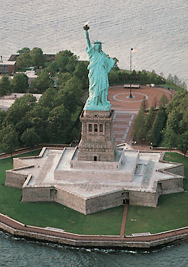July 4-10, 2013, Current Events Lesson Plan
Current Event:
On July 4, 2013, the Statue of Liberty officially reopened, eight months after Hurricane Sandy damaged the island on which the statue stands. The storm surge from Sandy that hit New York City on October 28, 2012, flooded about 75 percent of Liberty Island, seriously damaging the island’s infrastructure, including walkways, docks, electrical systems, and sewage pumps. Thanks to its iron framework, the statue itself was undamaged by the hurricane’s ferocious winds. Unfortunately, the Ellis Island Immigration Museum was completely flooded during the storm and remains closed for repairs. Coincidentally, just one day before Hurricane Sandy hit, the United States Department of the Interior had unveiled a yearlong, $27.25-million renovation of the statue and Liberty Island.

The Statue of Liberty, a symbol of the United States and a beacon of freedom for immigrants, stands on Liberty Island in New York Harbor. France gave the Statue of Liberty to the United States in 1884 as an expression of friendship. The monument rises above star-shaped Fort Wood, built during the early 1800's. ((c) George Goodwin, Monkmeyer)
Objective:
The Statue of Liberty is a majestic copper sculpture that towers above Liberty Island at the entrance to New York Harbor in Upper New York Bay. It is one of the largest statues ever built. The statue was given to the people of the United States by the people of France in 1884 as an expression of friendship and of the ideal of liberty shared by both peoples. The statue shows Liberty as a goddess draped in the graceful folds of a loose robe. In her uplifted right hand, she holds a glowing torch. She wears a crown with seven spikes that stand for the light of liberty shining on the seven seas and seven continents. With her left arm, she cradles a tablet bearing the date of the Declaration of Independence. A chain that represents tyranny (unjust rule) lies broken at her feet. From the 1890′s to the 1920′s, many millions of immigrants passed the Statue of Liberty as they entered the United States. Emma Lazarus’s poem “The New Colossus” was inscribed on a bronze plaque placed on the interior wall of the pedestal of the Liberty National Monument in 1903. In 1924, the Statue of Liberty became a national monument. The Behind the Headlines news stories and related World Book articles explore the Statue of Liberty and other famous structures.
Words to know:
- Ellis Island
- Emma Lazarus
- France
- Frederic Auguste Bartholdi
- Gustave Eiffel
- Hurricane Sandy
- Immigration
- Liberty Island
- New York City
- Statue of Liberty
- Statue of Liberty National Monument
Discussion Topics:
1. The Statue of Liberty was given to the people of the United States by the people of France. Ask your students what they know about France. (Students might say that it is one of the largest countries in Europe; Paris is the country’s capital and largest city; it has many famous landmarks including the Eiffel Tower and the Louvre; the national holiday is Bastille Day, July 14; famous French people include Charles de Gaulle, Joan of Arc, Louis XVI, and Napoleon.)
2. Ask your students to name other famous statues. (Students might say Christ the Redeemer in Brazil, Michelangelo’s David statue, the Great Sphinx, the Lincoln Memorial, the Moai on Easter Island, the terra-cotta army of Xi’an, the Thinker, Venus de Milo.)
3. Ask your students to explain what the word “Liberty” means to them.
4. Have your student read Emma Lazarus‘s poem, “The New Colossus.” Ask your students what they think of the poem. (The poem can be found in World Book’s Statue of Liberty article.)
5. Ask your students to use the World Book’s Timelines feature to create a timeline of famous structures around the world. (Students may wish to use the Related Information: Encyclopedia Articles page of World Book’s Architecture article for help. World Book also has many articles on individual structures.)


